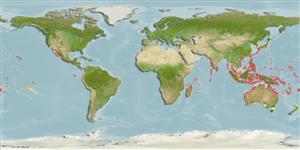>
Centrarchiformes (Basses) >
Kuhliidae (Aholeholes)
Etymology: Kuhlia: Because of Heindrich Kuhl, 1797-1821; researcher also with lizards (Gekkonidae).
Eponymy: Dr Heinrich Kuhl (1797–1821) was a German naturalist and zoologist. [...] (Ref. 128868), visit book page.
More on author: Lacepède.
Environment: milieu / climate zone / depth range / distribution range
Sinh thái học
Biển; Nước ngọt; Thuộc về nước lợ Cùng sống ở rạn san hô; Di cư sông biển (để đẻ trứng) (Ref. 51243); Mức độ sâu 0 - 5 m (Ref. 86942). Tropical; 20°C - 26°C (Ref. 2060)
Africa to Asia and Oceania: East Africa to Samoa, north to the Ryukyu Islands, south to Queensland, Australia and New Caledonia.
Length at first maturity / Bộ gần gũi / Khối lượng (Trọng lượng) / Age
Maturity: Lm 26.5, range 26 - 27 cm
Max length : 45.0 cm TL con đực/không giới tính; (Ref. 5329); common length : 25.0 cm SL con đực/không giới tính; (Ref. 2847); Khối lượng cực đại được công bố: 2.7 kg (Ref. 5329)
Các tia vây lưng cứng (tổng cộng) : 10; Các vây lưng mềm (tổng cộng) : 10 - 12; Tia cứng vây hậu môn: 3; Tia mềm vây hậu môn: 9 - 11. Diagnosis: Preorbital serrae 10-15 (obsolete in large specimens); body depth 2.6-3.0 in SL; mouth large for genus, maxilla reaching to below posterior half of eye; caudal fin emarginate, lobes somewhat rounded, caudal concavity 5.3-8.7 in head length (Ref. 41640). Reduced number of lateral line scales; 17-18(19) gillrakers on lower part of first bracnhial arch; body with spots (Ref. 79840).
Coloration: Silvery, the scales dorsally on body with black edges, those on side with a black bar or spot; juveniles with a broad black zone, edged above and below in white, in soft portion of dorsal fin, and each lobe of caudal fin with a large, white-edged black spot; black areas in these fins enlarge with growth until in adults most of these fins black (caudal with upper and lower edges and corners whitish) (Ref. 41640).
Primarily a freshwater inhabitant but may penetrate adjacent marine habitats (Ref. 41640). Adults occur in estuaries and the middle reaches of rivers; usually in relatively fast-flowing, clear streams (Ref. 2847, 79840). Usually in rainforests, as well as in rocky pools below waterfalls (Ref. 44894). Adults are omnivorous, feeding on small fishes, insects, crustaceans and fruits (figs) that drop into the water. Specific breeding habits are unknown, but adults move downstream into estuaries or to the sea to spawn (Ref. 44894). Neither anterolateral groove nor venom gland is present (Ref. 57406). Good food fish (Ref. 5329).
Life cycle and mating behavior
Chín muồi sinh dục | Sự tái sinh sản | Đẻ trứng | Các trứng | Sự sinh sản | Ấu trùng
Presumably non-guarders (RF).
Randall, J.E. and H.A. Randall, 2001. Review of the fishes of the genus Kuhlia (Perciformes: Kuhliidae) of the Central Pacific. Pac. Sci. 55(3):227-256. (Ref. 41640)
IUCN Red List Status (Ref. 130435: Version 2024-1)
Threat to humans
Harmless
Human uses
Các nghề cá: Tính thương mại; cá để chơi: đúng
Các công cụ
Special reports
Download XML
Các nguồn internet
Estimates based on models
Preferred temperature (Ref.
123201): 24.2 - 29.3, mean 28.4 °C (based on 2775 cells).
Phylogenetic diversity index (Ref.
82804): PD
50 = 0.5002 [Uniqueness, from 0.5 = low to 2.0 = high].
Bayesian length-weight: a=0.01413 (0.00597 - 0.03345), b=3.06 (2.85 - 3.27), in cm total length, based on LWR estimates for this (Sub)family-body shape (Ref.
93245).
Mức dinh dưỡng (Ref.
69278): 3.2 ±0.45 se; based on food items.
Thích nghi nhanh (Ref.
120179): Trung bình, thời gian nhân đôi của chủng quần tối thiểu là 1.4 - 4.4 năm (Preliminary K or Fecundity.).
Fishing Vulnerability (Ref.
59153): Low to moderate vulnerability (35 of 100).
Nutrients (Ref.
124155): Calcium = 47.5 [26.2, 74.1] mg/100g; Iron = 0.537 [0.323, 0.863] mg/100g; Protein = 19.4 [18.3, 20.4] %; Omega3 = 0.111 [0.070, 0.175] g/100g; Selenium = 19.4 [11.2, 34.6] μg/100g; VitaminA = 80.8 [27.4, 245.9] μg/100g; Zinc = 1.58 [1.13, 2.15] mg/100g (wet weight);
